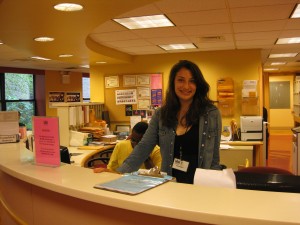Notes from a Doula
 In August of 2011, I accepted the unique position as a Women’s Health Advocate at a community health center in New York City. So, what does this Women’s Health Advocate job entail? Let me explain.
In August of 2011, I accepted the unique position as a Women’s Health Advocate at a community health center in New York City. So, what does this Women’s Health Advocate job entail? Let me explain.
I work with women who need reproductive health care as a doula. Wikipedia defines doula as, “a provider of non-medical support to women and families during labor, childbirth, and the postpartum period.” But my role goes beyond this more traditional definition of the doula to include support for the whole spectrum of reproductive care. I support women who come to the clinic for colposcopies (taking a sample of the cervix to screen for cancer), IUD insertions, and abortions. These women (and sometimes, teenagers) are scared, nervous, or completely calm. But however they’re feeling, for the 10 or 20 incredibly intimate minutes that our lives intersect, I’m their friend. During our time together, I make the patient comfortable and relaxed. Sometimes all it takes is holding a hand, or making sure the Pandora station is playing their favorite music. But, most of the time, we just chat about their lives – about what’s important to them.Through this job, I have met some amazing women, many of whom I wish I could be friends with post-procedure (some have even suggested I friend them on Facebook!). I’ve met opera singers, police officers, mothers, graphic designers, nannies, comedians, and students. I’ve heard happy stories about celebrity sightings or amazing NY apartment finds. I’ve heard sad stories about siblings in jail and unsatisfying careers. But mostly, I’ve heard dreams about what the future will hold, with an underlying message of how this procedure, whatever it may be – from protecting against unintended pregnancies, to screening for cancer – will allow these women to get where they hope to be.
 It’s hard to explain the impact each patient has on my life without sounding cliche or overly dramatic. But working at a community health center with a mission that accepts “all patients regardless of their ability to pay,” I really do interact with all types of people, and you know what? We all have something in common. Although the 19-year-old mother living in a half-way house seems miles away from the 38-year-old architect from England, I find a way to relate to each of my patients as I ease their anxieties and normalize their medical care.
It’s hard to explain the impact each patient has on my life without sounding cliche or overly dramatic. But working at a community health center with a mission that accepts “all patients regardless of their ability to pay,” I really do interact with all types of people, and you know what? We all have something in common. Although the 19-year-old mother living in a half-way house seems miles away from the 38-year-old architect from England, I find a way to relate to each of my patients as I ease their anxieties and normalize their medical care.
To give you an example of how powerful these moments can be: In my first month, a 20-year-old came in for an abortion after getting pregnant even with an IUD in place. This girl was frustrated that her birth control had failed, and scared for the procedure. But within a minute of walking in to the room, we were talking about all sorts of things, like how she’s in college and hopes to become a lawyer, and how she lives with her Mom but visits her Dad once a year in Mexico City, and has a cat named Ringo.
Once her visit was over, the nurse came in to check in and make sure she was okay. She said she was good, and pointed at me saying, “Me and this girl? We’re friends now!” She gave me a hug and went on her way. I’ll probably never see her again, but she had a profound impact on my life, and revealed how important a stranger’s conversation can be. It’s been wonderful to be on both the policy side as well as the direct-service side of reproductive health care, and I’ll be sad when my term is up, but grateful for the invaluable experiences I’ve gained.
